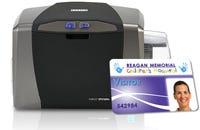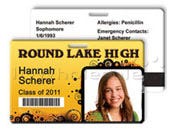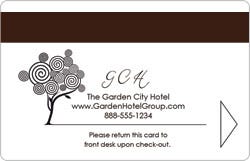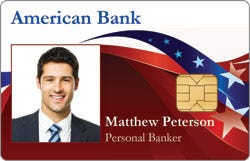We use cookies and similar technologies on our website to enable some essential functions for you. Learn more.

-
![50130 image]() Fargo DTC1250e ID Card Printer with Ethernet & Magnetic Stripe Encoding - Dual-Sided Item#: 50130Price $2,885.99 MSRP $5,317.99You Save: $2,432.00
Fargo DTC1250e ID Card Printer with Ethernet & Magnetic Stripe Encoding - Dual-Sided Item#: 50130Price $2,885.99 MSRP $5,317.99You Save: $2,432.00- Direct to card printing
- Dual-sided printing
- Magnetic stripe encoding
- Warranty: 3 years
- FREE 1 Year TrueSupport with purchase of 3 or 4 year True Support Plan
-
![50110 image]() Fargo DTC1250e ID Card Printer with Magnetic Stripe Encoding - Dual-Sided Item#: 50110Price $2,539.99 MSRP $4,902.99You Save: $2,363.00
Fargo DTC1250e ID Card Printer with Magnetic Stripe Encoding - Dual-Sided Item#: 50110Price $2,539.99 MSRP $4,902.99You Save: $2,363.00- Direct to card printing
- Dual-sided printing
- Magnetic stripe encoding
- Warranty: 3 years
- FREE 1 Year TrueSupport with purchase of 3 or 4 year True Support Plan
-
![50030 image]() Fargo DTC1250e ID Card Printer with Ethernet & Magnetic Stripe Encoding - Single-Sided Item#: 50030Price $2,920.99 MSRP $4,423.99You Save: $1,503.00
Fargo DTC1250e ID Card Printer with Ethernet & Magnetic Stripe Encoding - Single-Sided Item#: 50030Price $2,920.99 MSRP $4,423.99You Save: $1,503.00- Direct to card printing
- Single-sided printing
- Magnetic stripe encoding
- Warranty: 3 years
- FREE 1 Year TrueSupport with purchase of 3 or 4 year True Support Plan
-
![50010 image]() Fargo DTC1250e ID Card Printer with Magnetic Stripe Encoding - Single-Side Item#: 50010Price $1,905.99 MSRP $4,008.99You Save: $2,103.00
Fargo DTC1250e ID Card Printer with Magnetic Stripe Encoding - Single-Side Item#: 50010Price $1,905.99 MSRP $4,008.99You Save: $2,103.00- Direct to card printing
- Single-sided printing
- Magnetic stripe encoding
- Warranty: 3 years
- FREE 1 Year TrueSupport with purchase of 3 or 4 year True Support Plan
-
![50128 image]() Fargo DTC1250e ID Card Printer with Ethernet & Omnikey 5127 Encoders - Dual-Sided Item#: 50128Price $3,699.99 MSRP $5,594.99You Save: $1,895.00
Fargo DTC1250e ID Card Printer with Ethernet & Omnikey 5127 Encoders - Dual-Sided Item#: 50128Price $3,699.99 MSRP $5,594.99You Save: $1,895.00- Direct to card printing
- Dual-sided printing
- Omnikey 5127 Encoder
- Warranty: 3 years
- FREE 1 Year TrueSupport with purchase of 3 or 4 year True Support Plan
-
![50120 image]() Fargo DTC1250e ID Card Printer with Ethernet - Dual-Sided Item#: 50120Price $2,920.99 MSRP $4,487.99You Save: $1,567.00
Fargo DTC1250e ID Card Printer with Ethernet - Dual-Sided Item#: 50120Price $2,920.99 MSRP $4,487.99You Save: $1,567.00- Direct to card printing
- Dual-sided printing
- No Encoding
- Warranty: 3 years
- FREE 1 Year TrueSupport with purchase of 3 or 4 year True Support Plan
-
![50100 image]() Best Seller Fargo DTC1250e ID Card Printer - Dual-Sided Item#: 50100Price $1,847.99 MSRP $3,801.99You Save: $1,954.00
Best Seller Fargo DTC1250e ID Card Printer - Dual-Sided Item#: 50100Price $1,847.99 MSRP $3,801.99You Save: $1,954.00- Direct to card printing
- Dual-sided printing
- No Encoding
- Warranty: 3 years
- FREE 1 Year TrueSupport with purchase of 3 or 4 year True Support Plan
-
![50008 image]() Fargo DTC1250e ID Card Printer with Omnikey 5127 Encoder - Single-Sided Item#: 50008Price $2,822.99 MSRP $4,281.99You Save: $1,459.00
Fargo DTC1250e ID Card Printer with Omnikey 5127 Encoder - Single-Sided Item#: 50008Price $2,822.99 MSRP $4,281.99You Save: $1,459.00- Direct to card printing
- Single-sided printing
- Omnikey 5127 Encoder
- Warranty: 3 years
- FREE 1 Year TrueSupport with purchase of 3 or 4 year True Support Plan
-
![50018 image]() Fargo DTC1250e ID Card Printer with Magnetic Stripe & Omnikey 5127 Encoders - Single-Sided Item#: 50018Price $3,406.99 MSRP $5,109.99You Save: $1,703.00
Fargo DTC1250e ID Card Printer with Magnetic Stripe & Omnikey 5127 Encoders - Single-Sided Item#: 50018Price $3,406.99 MSRP $5,109.99You Save: $1,703.00- Direct to card printing
- Single-sided printing
- Magnetic & Omnikey 5127 Encoders
- Warranty: 3 years
- FREE 1 Year TrueSupport with purchase of 3 or 4 year True Support Plan
-
![50138 image]() Fargo DTC1250e ID Card Printer with Ethernet, Magnetic Stripe, & Omnikey 5127 Encoders - Dual-Sided Item#: 50138Price $4,282.99 MSRP $6,423.99You Save: $2,141.00
Fargo DTC1250e ID Card Printer with Ethernet, Magnetic Stripe, & Omnikey 5127 Encoders - Dual-Sided Item#: 50138Price $4,282.99 MSRP $6,423.99You Save: $2,141.00- Direct to card printing
- Dual-sided printing
- Magnetic & Omnikey 5127 Encoders
- Warranty: 3 years
- FREE 1 Year TrueSupport with purchase of 3 or 4 year True Support Plan
-
![50028 image]() Fargo DTC1250e ID Card Printer with Ethernet & Omnikey 5127 Encoders - Single-Sided Item#: 50028Price $3,112.99 MSRP $4,694.99You Save: $1,582.00
Fargo DTC1250e ID Card Printer with Ethernet & Omnikey 5127 Encoders - Single-Sided Item#: 50028Price $3,112.99 MSRP $4,694.99You Save: $1,582.00- Direct to card printing
- Single-sided printing
- Omnikey 5127 Encoder
- Warranty: 3 years
- FREE 1 Year TrueSupport with purchase of 3 or 4 year True Support Plan
-
![50020 image]() Fargo DTC1250e ID Card Printer with Ethernet - Single-Sided Item#: 50020Price $2,359.99 MSRP $3,593.99You Save: $1,234.00
Fargo DTC1250e ID Card Printer with Ethernet - Single-Sided Item#: 50020Price $2,359.99 MSRP $3,593.99You Save: $1,234.00- Direct to card printing
- Single-sided printing
- No Encoding
- Warranty: 3 years
- FREE 1 Year TrueSupport with purchase of 3 or 4 year True Support Plan
-
![50038 image]() Fargo DTC1250e ID Card Printer with Ethernet, Magnetic Stripe, & Omnikey 5127 Encoders - Single-Side Item#: 50038Price $3,699.99 MSRP $5,524.99You Save: $1,825.00
Fargo DTC1250e ID Card Printer with Ethernet, Magnetic Stripe, & Omnikey 5127 Encoders - Single-Side Item#: 50038Price $3,699.99 MSRP $5,524.99You Save: $1,825.00- Direct to card printing
- Single-sided printing
- Magnetic & Omnikey 5127 Encoders
- Warranty: 3 years
- FREE 1 Year TrueSupport with purchase of 3 or 4 year True Support Plan
-
![50000 image]() Best Seller Fargo DTC1250e ID Card Printer - Single-Sided Item#: 50000Price $1,213.99 MSRP $2,899.99You Save: $1,686.00
Best Seller Fargo DTC1250e ID Card Printer - Single-Sided Item#: 50000Price $1,213.99 MSRP $2,899.99You Save: $1,686.00- Direct to card printing
- Single-sided printing
- No Encoding
- Warranty: 3 years
- FREE 1 Year TrueSupport with purchase of 3 or 4 year True Support Plan
-
![50118 image]() Fargo DTC1250e ID Card Printer with Magnetic Stripe & Omnikey 5127 Encoders - Dual-Sided Item#: 50118Price $3,990.99 MSRP $6,009.99You Save: $2,019.00
Fargo DTC1250e ID Card Printer with Magnetic Stripe & Omnikey 5127 Encoders - Dual-Sided Item#: 50118Price $3,990.99 MSRP $6,009.99You Save: $2,019.00- Direct to card printing
- Dual-sided printing
- Magnetic stripe encoding
- Warranty: 3 years
- FREE 1 Year TrueSupport with purchase of 3 or 4 year True Support Plan
-
![Fargo DTC1250e ID Card Printer with Omnikey 5127 Encoder - Dual-Sided]() Fargo DTC1250e ID Card Printer with Omnikey 5127 Encoder - Dual-Sided Item#: 50108Price $3,407.99 MSRP $5,180.99You Save: $1,773.00
Fargo DTC1250e ID Card Printer with Omnikey 5127 Encoder - Dual-Sided Item#: 50108Price $3,407.99 MSRP $5,180.99You Save: $1,773.00- Direct to card printing
- Dual-sided printing
- Warranty: 3 years
- FREE 1 Year TrueSupport with purchase of 3 or 4 year True Support Plan















